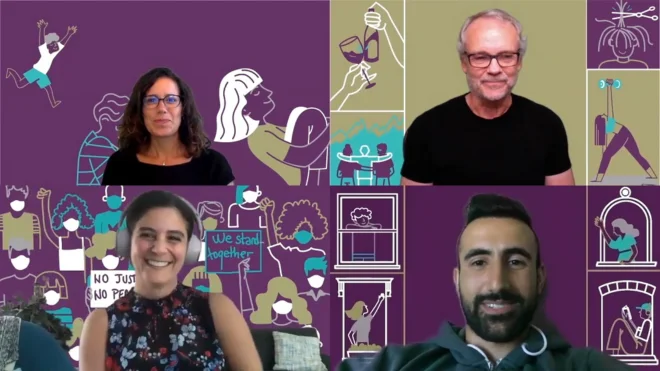
An industry event is a perfect setting to plan and create short testimonial videos. You’ve got a large group of your customers all in one place, as well as experts in your field who can talk intelligently about the benefits of working with or buying from your company. But aside from planning your key company video storytelling message, you must know the practical part of shooting video testimonials onsite.
This guide will give you the basics to help you plan your own effective video testimonial shoot at a trade show or conference.
Who Makes Up Your Optimal Team?
One person with a camera is not enough to make the effective videos you need, but you don’t want to overwhelm your interview subjects with enough staff to rival a Hollywood production. Here’s exactly who you need for an optimal onsite production team:
- Videographer
- Interviewer
- Scheduler who plans, finds, and coordinates the people who will be interviewed
- Production assistant to help with setup, run errands as needed, and be an extra hand
- Person who manages release forms
The scheduler is a key part of the team because you want to keep the flow of interviewees coming in smoothly. You don’t want people to be waiting or for your person on camera to have to give testimonials in front of a large audience as that could result in more stilted or awkward answers.
What Equipment Do You Need?
Big lights and conspicuous cameras only serve to make an interviewee self-conscious. A smaller setup that yields the quality you want is the best way to create testimonial videos onsite. Many marketing teams use a DSLR or mirrorless camera that also shoots video well in lower light as a good option.
As good sound is crucial to an effective testimonial, having the right microphone is key. A wireless handheld mic can be a good choice if your interviewer is comfortable and smooth with handing it off. Wireless lav mics clipped to your interviewee’s lapel will often pick up too much surrounding sound from the event. You also want to avoid larger mics and boom mics that will definitely pick up excessive background noise.
How about lighting? It’s best to avoid clunky lights if you can use natural light instead. Unfortunately, in many conference centers, that’s a challenge. Keep your lights minimal and aim for a low-key setup.
Where Should You Shoot?
Trade shows offer a great backdrop to create testimonial videos; they’re always changing and moving. If you don’t want the busy background, look for a place where you can shift slightly for different looks (you typically won’t want the exact same, easily identifiable background for multiple testimonials). If you’re not looking for the trade show feel in your videos, many conference organizers make a few quiet rooms available for shooting interviews.
Of course, lighting is a factor as well. Natural light is best, but hard to find in many industry event locations. Going outdoors is typically not possible as the climate can be uncomfortable, the lighting too bright and the distance to travel inconvenient for most interviewees.
When Is the Best Time During an Industry Event to Shoot?
If your company has a booth at your industry event, it’s tempting to create your testimonial videos there. You’ve got a backdrop that shows your people and your products, and you can recruit potential interviewees more easily. In this case, you can pull people who are visiting the booth throughout the day.
Shooting can also work well after a speaker or breakout session when someone from your business has participated. The audience is interested in your company and easy to recruit from. It can be more difficult to convince a session attendee to come away and be interviewed, depending on what’s next on the event schedule. If the session is the last of the morning or afternoon, when people are going to find something to eat, they may be less willing to participate.
You can also work with your sales team to schedule your larger customers for interviews. Remember, though, that industry events often run long or people forget, and plan on having a way to confirm appointments for video interviews.
How Do You Convince People to Participate?
If you haven’t scheduled existing customers in advance, you’ll need to talk to people about what you’re doing and why you want to hear their thoughts. Choose a diverse group to interview so you have testimonials that appeal to many types of potential customers.
Your scheduler should be friendly and willing to put people at ease with a short response about how the testimonials will be used for your company’s website, social media, and other marketing materials. Most important, however, is letting people know it won’t take much time. Participants are trying to pack a lot into a short event and don’t want to spend more than 5 or 10 minutes being interviewed. Your scheduler can emphasize the great responses you’ve been getting and the fun people have had sharing their thoughts as well as the short amount of time needed.
Do You Need Release Forms?
Always have release forms for those who give testimonials. Ask them to sign the form after their interview. Of course, if the flow during your situation makes more sense to have participants sign a release before their interviews, do that. It can be a good way to fill the time when they’re waiting for their turn.
Our release form template can be used as-is or customized for your company. If your firm has legal representation, ask them to look over any form you use.
What Should You Ask to Get the Best Testimonials?
Specific questions usually set the stage for the best testimonials. Think about what you want to have a customer say and ask questions to elicit that response. You can even write out some “ideal” testimonials so you better know what you’re aiming for.
Tips for Interviewers
- Have good energy. An upbeat interviewer is vital to getting people who are willing to express themselves. People also mirror those they are speaking with, so an enthusiastic interview will produce the best results.
- Use nonverbal cues to acknowledge their answers. Your videos aren’t supposed to have an obvious interviewer, so you don’t want to speak after their answers, but nodding and smiling can help the subjects feel at ease.
- Communicate closely with the videographer. Make sure they’re ready and don’t have thoughts on how to improve your questions.
- Plan to ask about 3 to 5 questions per interviewee, but don’t hesitate to stop if you’ve got what you need after one response.
- Make sure there is a pause between the interviewee’s response and your next question. You avoid “stepping on” their answer and it’s easier for editing the video.
- Brief your speakers to answer in full sentences since your interviewer will be off-camera and their stated questions will not be in the video. For example, if you ask, “What’s your favorite product in our line?” and the interviewee says, “XYZ product” it will be hard to use. Make sure you let people know that you’ll need complete responses from them, like “XYZ product is my favorite in your line.”
Getting the Answers You Want
Track the answers you’re getting so you can record a variety. If multiple people start to talk about one feature, ask the next person about a different feature. You might need to ask a few questions or approach the topic a different way if you’re not getting an immediate answer or one that will achieve your goals.
You’re also going to get some interviewees who just aren’t going to work for your needs. If they act awkward or unconvincing, or their responses aren’t useful after a few tries, don’t hesitate to politely cut your losses. Thank them and tell them you have what you need, then move on to the next person.




